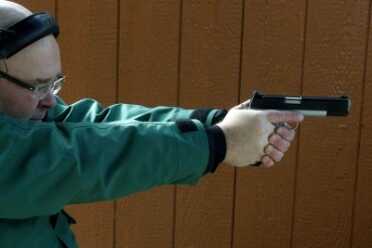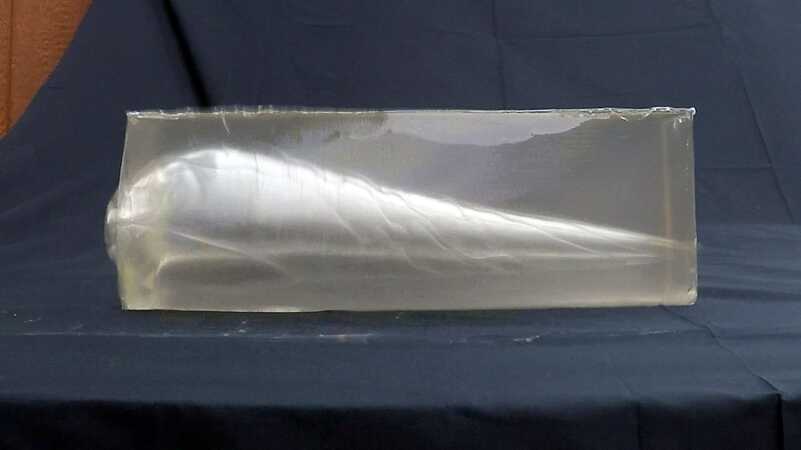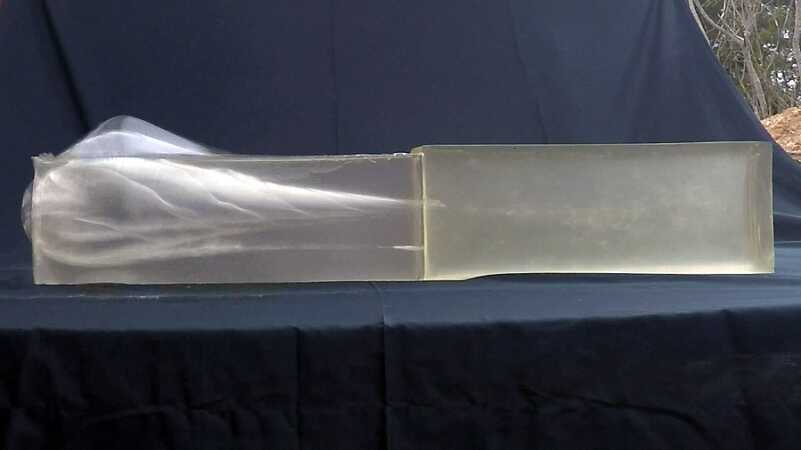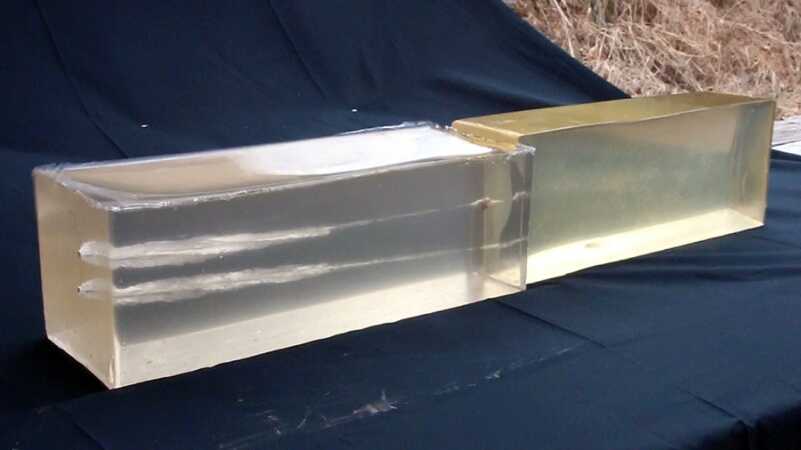[full_width][/full_width]
SIG SAUER is Serious for Super
Sig’s ammo: https://www.sigsauer.com/Ammunition/
The .38 Super is now available from Sig Sauer, with both the proprietary SIG V-Crown for personal defense and the full metal jacket suitable for practice and range work.
The SIG V-Crown uses a stacked hollow point bullet featuring an additional smaller hollow point cavity behind the main cavity. This design guarantees controlled, uniform expansion. Another clever aspect of the design is the inclusion of a toothed cannelure halfway up the shank of the bullet. It locks the jacket and the lead/alloy core, to achieve maximum weight retention and energy by preventing fragmentation as the bullet mushrooms. Brass cases are Techni-crom coated for lubricity, corrosion resistance, and reliable feeding.
[full_width]
[/full_width]
Some History
In 2014, Sig Sauer announced that they would be entering the ammunition market. Their flagship product was the Elite Performance for personal defense, which covered all of the major calibers. This ammunition would be made in Kentucky, but produced with machines that were owned by Sig Sauer, run by Sig Sauer employees, and with Sig Sauer Specifications. This was to be a temporary arrangement, lasting only until they could open their own facility. At the 2016 Shotshow, the Governor of Arkansas announced that Sig Sauer would be relocating their manufacturing operation to Jacksonville, Arkansas. Since then, Sig Sauer has added calibers to their Elite Performance line, and they have also introduced full metal jacket practice ammunition in a wide variety of calibers.
Is .38 Super an Obsolete Caliber?
The .38 Super was introduced in the late 1920s as a higher pressure loading of the .38 ACP or .38 Auto. The cartridge was designed for use in the M1911 pistol, and was capable of penetrating the body armor and automobile bodies of the time. This technology was necessitated by the tactics criminals had adopted to combat the handgun rounds of the day. The .357 Magnum revolver burst onto the scene in 1934, and quickly usurped the 1911 pistol in .38 Super as the primary demand of police departments everywhere. I don’t think that the 38 Super round is obsolete, so much as it’s simply forgotten. In Latin America, where civilians are not allowed to own a caliber that the police or military use, the .38 Super is still a viable choice.
The caliber saw a rise in popularity back in the United States in the 1980s, due to the expanding popularity of competitive shooting- it had sufficient pressures to operate a compensator, providing just the level of power needed without compromising accuracy. My attraction to this caliber lies in its performance in a self-defense gun; it is more robust than a 9mm. With an almost imperceptible difference in recoil and no loss in magazine capacity. In my experience, the .38 Super also offers enhanced feeding in the 1911 form when compared to standard 9mm. Parabellum. The .38’s case length is identical to the 45 ACP, which resolves numerous potential feeding issues.
Ammunition Data
Both of the Sig rounds I tested were listed at 1230 FPS from the muzzle. Using a PC Digital Chronograph from Competition Electronics, three rounds of each type of ammunition were tested at 10 feet from the muzzle. Prior to firing, the muzzle was raised to 90 degrees and then slowly lowered to the target. This allowed all of the propellant to be at the rear of the case. Most shooting sports utilize some variant of this method to test ammunition.[one_half]
| Sig V Crown 125GR JHP | Sig FMJ 125GR RN | ||
| 1 | 1274 | 1 | 1249 |
| 2 | 1295 | 2 | 1241 |
| 3 | 1283 | 3 | 1253 |
[/one_half][one_half_last]
[/one_half_last]
I took this opportunity to bust out my new Dillon Precision D – Terminator scale to weigh the components of each of the test rounds. I observed that the powder charge composition and weight appeared to be identical in both rounds. The cases were different, with the V Crown being nickel-plated while the FMJ was a traditional brass case. Both of the bullet weights were listed at 125 grains, and I did measure some very slight deviations from the published weight of each round. It seems clear that Sig Sauer’s objective was to produce practice rounds that would function and feel the same as the self-defense rounds, and these measurements seem to indicate that the goal was carefully met. This consistency is ideal for saving a few bucks on training while still maintaining maximum feel and performance between the two rounds.
| Sig V Crown 125GR JHP | Sig FMJ 125GR RN | ||
| Bullet Weight | 124.3 | Bullet Weight | 125.2 |
| Power Charge | 6.5 | Power Charge | 6.5 |
| Empty Case | 68.4 | Empty Case | 68.3 |
| Total Weight | 199.2 | Total Weight | 200 |
[one_half]
[/one_half][one_half_last]
[/one_half_last]
[one_half]
[/one_half][one_half_last]
[/one_half_last]
Ballistic Gelatin
All of my testing was done using Clear Ballistics synthetic gelatin, which is the best gelatin that I have ever used. Not only does its clear coloration allow for filming, it is also remarkably stable under a full range of temperatures. The days of having to keep a block of gelatin refrigerated, and then scrambling to set up, test, and get back in the cool are gone. Good riddance.
[full_width]
[/full_width]
We were somewhat surprised when the first round we fired exited the back of the 16″ block of gelatin we had just fired it into. So for the second shot, we placed an additional block of Clear Ballistics gel behind the first one. One of the phenomena that you may experience when working with gel is that the suction that it creates will sometimes pull the bullet back into the permanent wound cavity. By simply placing the second block, we created an environment that allowed the vacuum to pull the bullet back into the first block. The overall penetration of the round was measured at 15.5”. The temporary wound cavity captured by the camera was quite incredible, and the permanent wound cavity was about 250% larger than the projectile.
[full_width]
[/full_width]
Final Thoughts
Sig Sauer has delivered on every promise that they made for this round. The velocity was there, the fired projectile looked exactly like the picture on the box, and accuracy and reliability were 100%. At this point in an article I will usually list anything negative that didn’t fit in the other broad topics, and weigh in on the final pros and cons. I have to be honest- I am struggling to find something to bitch about this time! I fully recommend this ammunition and will be carrying it in my .38 Super 1911.
The V-Crown rounds (20) have an MSRP of $22.95. The FMJ (50) is $28 a box.
[one_half]
[/one_half][one_half_last]
[/one_half_last]
[one_half]
[/one_half][one_half_last]
[/one_half_last]
[one_half]

The gun we used for the testing? More on that to come. .38 Supers are not as easy to come by these days as 9mms and .45s.
[/one_half][one_half_last]

Consistent powder loads across both the practice ammo and the carry line make for consistent performance between two very different price points.
[/one_half_last]















Thanks for excellent review. I’ve found this ammo accurate in my own Super 38s as well.
You are correct about the handloaded Super 38 working well with a compensator, which made it a more competitive choice in an Open USPSA division pistol.
Ignore “Dean Spier”… he has been a sanctimonious a** his entire life, and the closest he has ever come to an USPSA match, is watching it from the sidelines. A greater pretender there never was!
The author’s commentary about the “revival” of the .38 Super in the 1980s replete with misinformation.
Yes, it was “due to the expanding popularity of competitive shooting” (specifically IPSC led by run ‘n’ gun ace Chip McCormick), but had precious little to do with “sufficient pressures to operate a compensator” and everything to do with two other factors:
1.- The ability of the shooter to drive a lighter recoiling projectile (115-130 grains v.the 200-230 grain .45 ACP) at velocities sufficient to satisfy IPSC’s Major Power Factor classification;
2.- Two additional rounds of ammo, allowing for fewer magazine changes, important in the increasingly complex high round count stages of fire.
Most curious is the author’s assertion “In my experience, the .38 Super also offers enhanced feeding in the 1911 form when compared to standard 9mm. Parabellum.” This completely ignores the fact that the .38 Super cartridge is of semi-rimmed construction, and was increasingly problematic in respect to feeding issues.
I don’t mean to speak ill of the deceased, but this was typical Dean Spier commentary from the failed journalist and would-be politician turned self-proclaimed “firearms expert”: accusing others of misinformation, then spewing out reams of BS himself.
The author of the article is correct. The higher-pressure .38 Super cartridge allowed a compensator to work as intended on the 1911 pistol – the .45 ACP did not.
The former windbag’s other two points are also incorrect: 1. Most .38 Super “major power factor” shooters used 140-150 grain bullets, not lightweight bullets. 2. The .38 Super was always completely reliable in original design 1911 pistols, regardless of the semi-rimmed design. When STI began produced “double-stack” 1911 guns, the rimmed .38 Super – which was not de4isgned for type of magazine – being problematical. As a result, .38 Super rimless derivatives were developed, including the .38 Super Comp.
RIP Dean Spier
$28 a box for practice ammo? when you could practice with ballistically identical 9mm actual duty ammo for less than that? why?
How did you determine the permanent cavity is about 250% larger than the projectile?
Have loved the round since I got my first 38 Super in 1972, thought it was one of the best then and with this Sig ammo, certainly is a performer
Just tried the SIG .38 Special 125 gr. V-Crown JHP +P thru a Taurus M85 2″ and got an ave. 856 FPS, plus ave. 5-shot group at 10 yards was 2.04″. No gel testing done…yet.